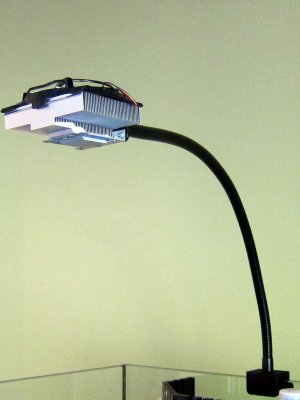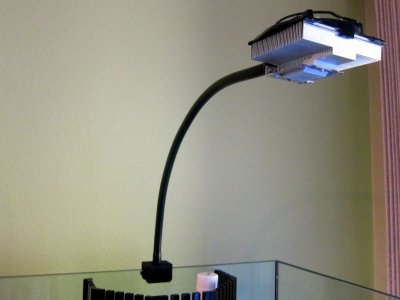I posted this in my club's forum for our members, but thought I should post it here also, as inspiration, as I have gotten much of it from this thread and the many posters here. What an awesome thread and so many great designs and ideas! Thanks for the inspiration!
Here is the info on my 100w LED chip build. I was considering finally ordering new Radium MH bulbs when i saw some of the posts on the DIY Multichip thread and though I'd try it out. The total for each of the chips + drivers + cooling fans would be comparable to buying two new Radium bulbs.
LED Chip from aallion2008 on Ebay. I asked for the 20K version.
Link
HERE
Features:
Rated voltage: 30-36V DC Output power:100W
View angle: 120 degree
Lumen output: 9000Lm
Reflector efficiency: 90%
Light source: 1pcs 100w High Power HCC LED
LED working temperature: <65°C
Color temperature: 20000K
Source life: > 50,000 hours
CRI: >87
SIZE: 52mm(W)*56mm(L)
Optics
I used the optics provided by the seller that match the LED. These are plastic reflectors / holders that pop onto the LED using some pegs & holes. I used the thermal adhesive to bond the reflector to the LED. I then used more adhesive to bond the glass optic to the reflector. On ebay they call them Collimators.
Non-Dimmable Drivers from hiyaseller on Ebay
Link
Here
Input Voltage: AC 100V-240V 50/60Hz
Output Voltage: 30V-36V
Current: 3A
Waterproof: IP67
Operating Temperature: -20~80
Storage Temperature: -20~80
Package Material: Aluminum
Dimensions: L18.1 xW7.0 xH4.3 cm
Weight: about 0.8kg
Cooling
I saw a lot of people were using those monster heatpipe and VGA coolers which, I personally thought was overkill. Using my experience from building many computers and many LEDS, I decided that something smaller would work just fine as long as it was rated for a 90+ watt cpu. These heatsink must wick heat away from a processor in a small, usually enclosed box, where ambient temps can be 90+ degrees. My ambient temperature in the fish room is around 75-78 degrees. This should allow me to get away with a smaller heatsink and fan. I choose the
Arctic Cooling Alpine 64 Pro Rev 2. from Amazon for $15.99.
Product Features
- Alpine 64 PRO Rev.2 is one of the most cost-efficient coolers of its class.
- The cooler features an optimized heatsink and a 92mm PWM controlled fan for efficient heat dissipation.
- The Alpine 64 PRO Rev.2 is compatible with AMD Socket FM1, AM3+, AM3, AM2+, AM2 and 939.
- The buffered-mounted 92mm PWM fan guarantees sufficient cooling at lowest noise.
- With the combination of the patented fan case, low noise impeller and vibration absorption, the Alpine 64 PRO Rev.2 generates a maximum of 0.4 sone at full speed.
This heatsink's mounting area is perfectly sized for the LED's aluminum base.
You guys saw this at the meeting.
Mounting
I mounted the LED to the heatsink using
Arctic Silver Arctic Alumina Thermal Adhesive. I also used this adhesive to mount the lens and reflector to the LED. Just make sure you clean the heatsink (wipe off the supplied compound) with rubbing alcohol or a small amount of acetone before bonding.
I could have just mounted the LEDS above the tank, however i did notice that even with the lens the light would still spread at a wider angle. To collect this light, I modified my Lumenarc Mini Wide pendants to accept the LEDS. I drilled out the rivets of the top plate and placed the LED through the top. I still need to find a way to mount them more permanently then just resting, however they fit quite well into the opening. This allows the excess light to be directed into the tank and cut down on some of the shadows you typically get with a more focused LED light.
Here is a pic.
I'll take some more pictures as I build the second one. For now I will be running this one along with the other 250w MH.
MH Off and LED on - Right Side.
MH Off and LED on - Left Side.
So for this build without the Lumenarc, you are looking at:
Driver - $33.00
LEd - $35.00
Heatsink & Fan - 15.99
12V Power supply - I had many laying around.
Performance
According to the Killawatt, The 100W LED is pulling 1.23 Amps and about 105watts.
Using my PAR meter, the numbers are almost exactly the same as my 250 Watt 20K bulbs. The top shelf gets around 450-500 PAR where my ORA Red Planet colony is.
Heatsink & Fan - While running with the fan, the heatsink plate on the LEd peaks at about 43-45 Celsius, with the heatsink running around 37 Celsius.
Not bad as I am saving about 150 Watts per side. As for the corals, I'll update their response as time goes by. I'll also take some pics with the MH on so you can compare. Although I did buy the 20K LED, it looks more like a 14-16K, still very nice and looks brighter by comparison. The spread looks to be about the same as my MH fixtures, as this is a 36" wide tank. I use the outsides for LPS and lower light corals and that has worked out well. On a 18" or 24" tank, this would be perfect spread.
Hope you guys find this useful and a potentially easier and cheaper alternative to the 3w chip builds (of which I still have a few of

).
Updates can be found in the ARKSC forum here:
LINK









